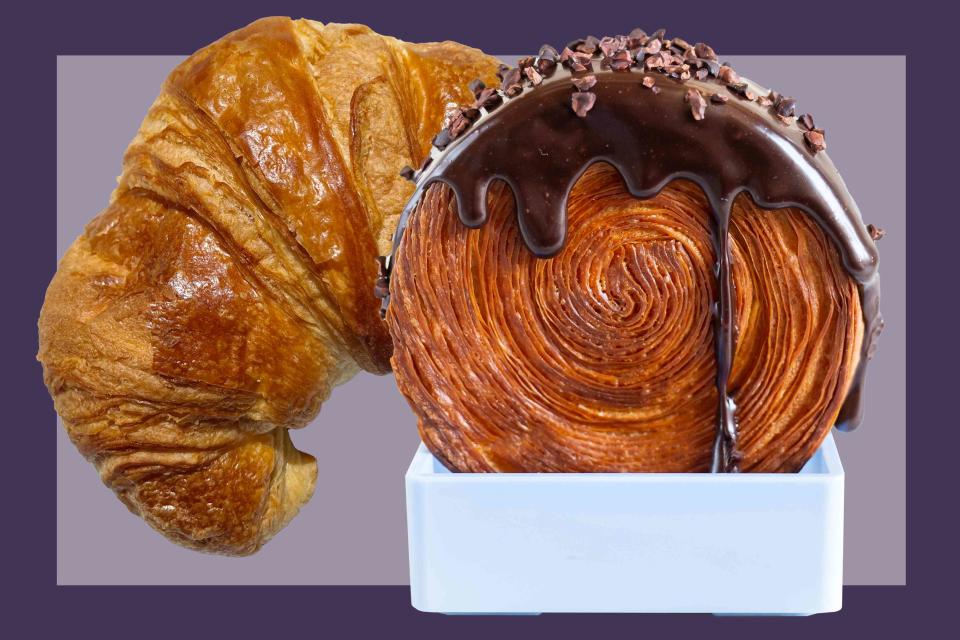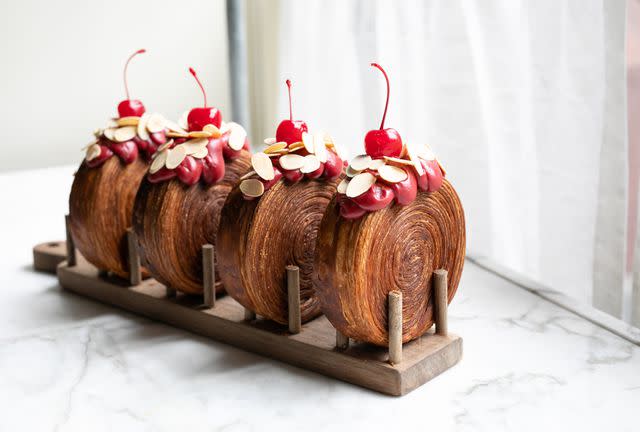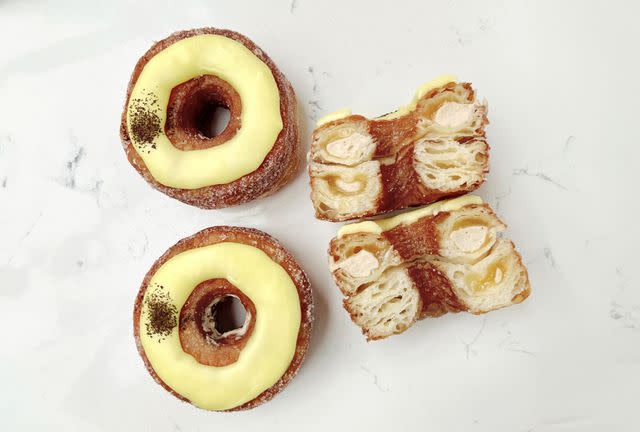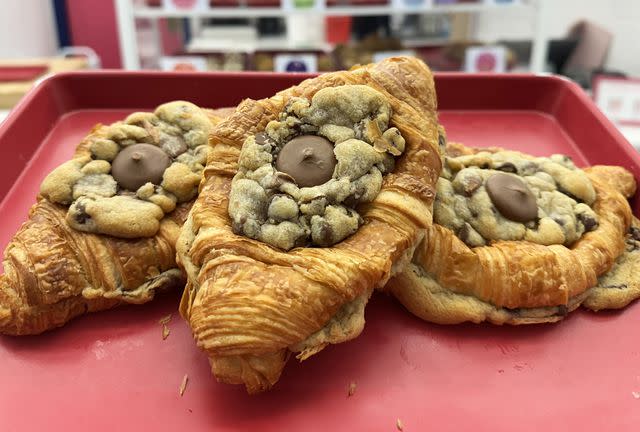Are Croissant Trends Getting Out of Control?
- Oops!Something went wrong.Please try again later.
Look what the Cronut hath wrought.

Food & Wine / Doan Nguyen / Lafayette bakery / Briana Balducci
Since 2013 the croissant has been under siege.
It all began with Dominique Ansel’s cult creation, the Cronut, which fused the crescent-shaped pastry with a good ol’ fashioned doughnut. And the buttery slope got slippier from there.
Equal parts breakfast and dessert, the Cronut was invented by the pastry legend as a way to rethink laminated dough. It took Ansel over two months to perfect the recipe, which had him frying a doughnut-shaped round of buttery, croissant-like dough, filling it with cream or jam, before topping the whole thing off with icing. The result was, quite literally, an overnight success — within days of its release, the line was more than a hundred people deep.
Related: These Viral Cookie-Like Croissants Are a New Way to Enjoy Day-Old Pastries
"If you ask me to explain why the Cronut took off the way it did, I honestly don't know if I can,” says the Beauvais-born Ansel, who moved to New York in 2006 to serve as executive pastry chef at Daniel Bouloud’s Daniel. “It was just an instance where so many things came together — social media, pastry culture, and a little creativity. That's also what made it so special — an unplanned, genuine moment in time."
The Cronut was the first of its kind in more ways than one: It was not only an entirely new creation (albeit, a blend of two popular, well-known ones) — it also marked the first pastry release to go mega-viral on Instagram. This makes sense, considering the photo-sharing social media platform, which launched in 2010, made it a infinitely easier to share food photos with the world. And the baked confection, while not necessarily pristine, was unbelievably photogenic thanks to its fluffy, cream-coated layers.
Related: 10 Classic French Pastries You Have to Try on Your Next Trip to France
Since then, many other sweet inventions have followed Ansel’s Cronut success. There were Black Tap’s over-the-top CrazyShakes in 2015, Darren Wong’s Raindrop Cakes in 2016, and who could forget Little Damage’s 2017 hit — the Goth Cone?
Although these were certainly the treats of the moment, inescapable on local food influencers’ Instagram feeds and bloggers’ lists of “Things to Eat in XX City,” it seems that it’s impossible for a trend to reach Cronut-level fame — or infamy, depending on how big of a Scrooge you are — unless it’s laminated.

Lafayette bakery / Briana Balducci
The round, cream-filled Croissant Suprêmes at Lafayette Bakery were created as a way to draw passersby to the pastry counter after being closed during the pandemic.There’s something about the croissant, a pastry made from dough that’s folded over blocks of cold butter to create a dramatic layered effect and flaky texture, that gets people out the door and in line.
“Historically, pastries go through these cycles of trends,” explains 2022 Food & Wine Best New Chef Emily Riddell. “It seems like croissants were getting really trendy, and I expected it to naturally fade, but it doesn’t seem like it has. My only guess [why] is because croissants are kind of a blank canvas. You can really do anything with it and it has great texture, so it lends itself to having different flavors added.”
Related: Bakers Say These Silicone Mats Are 'Just as Good' as the Expensive Brands for Half the Price
More of a traditionalist, Riddell generally rejects zany pastry creations at her South Philadelphia bakery, Machine Shop, but even she recognizes when you have to give in to consumer demand. “When we opened Machine Shop, we were looking into an everything bagel croissant. I was like, ‘I don’t know about this. This makes me feel uncomfortable,’” said the Philly-born pâtissier. “But it’s been on our menu every single day since and people love it. There's definitely a place for it and a space for it.”

Dominique Ansel Bakery
The Cronut, created by Dominique Ansel in 2013, was an instant hit in New York City — paving the way for future croissant innovations.Of course, most bakers aren’t thinking, “How do I attract Gen-Z influencers on TikTok” during their R&D process. In fact, the creators of today’s most ubiquitous croissant innovations never considered virality at all.
That Petite Croissant Céréale from L’Appartment 4F in Brooklyn Heights? It was created as a reward for people who supported the bakery’s early Kickstarter campaign. The round, cream-filled Croissant Suprêmes at Lafayette Bakery? They were invented as a way to draw passersby to the pastry counter after being closed during the pandemic.
“Somebody told me, ‘This is getting so many views on TikTok’ and three years ago I was like ‘Okay, cool. I have no idea what that means,” says Lafayette pastry chef Scott Cioe, who invented the Croissant Suprême. “Three days later, we had a line out front.”
The circular croissant with round laminations is filled and glazed in a similar style to an eclair. There’s a pistachio flavor, a chocolate flavor, and a third flavor that changes with the season — tear the croissant open and it oozes with technicolored cream.
But while the explosion of filling is dramatic and the garnishes whimsical, the reason the viennoiserie has maintained its virality is simple: It’s a croissant. “A croissant has a universal appeal,” says Cioe. “Nobody hates flaky butter.”
A croissant alone is the perfect blend of style and substance. It’s a timeless classic that is at once delicious and eye-catching by design. So if a plain croissant can capture the heart of so many pastry lovers around the world, then a croissant innovation is set up for tremendous success.
Related: 10 Top International Cities for Bakeries, According to the Experts
“They’re exciting, enticing, something new, and often visually stunning,” says 2022 Food & Wine Best New Chef Caroline Schiff. “This classic dough we’re familiar with all of a sudden gets a whole new look.”
During the last month alone, two riffs on the classic croissant went viral on TikTok. Flat croissants, a trend that originated in South Korea, where day-old croissants are pressed, coated in butter, then baked or pan-fried, have taken the United States by storm. The crunchy, 2-D pastry is being served at Coin de Rue in Los Angeles, Alexander’s Patisserie in San Francisco, and The Snackery Bakeshop in Rye, New York — in addition to countless others.
Stéphane Louvard’s Paris boulangerie, Maison Louvard in the ninth arrondissement, invented Le Crookie, a croissant stuffed with cookie dough, and it has already been replicated at pastry shops across the United States — like Janie’s Life Changing Baked Goods’ half baked chocolate chip cookie dough croissant and Chip City’s Crookie, which is more of a croissant-cookie than a cookie-croissant.
Related: Seoul's Independent Bakeries Are the Sweet Soul of the City
With TikTok and Instagram reels making it easier to yearn for a niche food experience on the other side of the globe, it’s understandable why so many bakers want to capitalize on a trend. And when it’s a croissant trend, all the better.

Janie's Life-Changing Baked Goods
Stéphane Louvard’s Paris boulangerie, Maison Louvard in the ninth arrondissement, invented Le Crookie, a croissant stuffed with cookie dough. These days, it's everywhere — from Janie's Life Changing Baked Goods to Chip City.“Of course you want to be involved in the conversation when something is all over Instagram and TikTok,” says Janie Deegan, founder of Janie’s Life-Changing Baked Goods. “Most of the pastry chefs jumping in with their own spin are either already making croissants, or in my case, have easy access to amazing croissants. So in that regard, there’s not a huge barrier to entry.”
“It’s such a fun way to play with a classic dough already in our repertoire,” adds Schiff. “It serves as this wonderfully buttery, flaky canvas for both sweet and savory accompaniments. There’s also a practicality to it. One dough yields dozens of different pastries, and this can keep labor in check too.”
When a pastry or dessert shop has already got its croissant formula down to a tee, why not experiment with new colors, fillings, and shapes?
Well, some people disagree. In my extremely informal poll on Instagram, I asked how people felt about trendy croissant riffs and a quarter of respondents said, “The more, the merrier.” While a solid 36 percent said that they’re “always overrated.”
Related: Whole Foods Is Making Early Predictions for the Biggest Food Trends of 2024
There are also many croissant purists out there who think no croissant creation, no matter how stunning, could come close to the plain version available at any patisserie in France. In fact, responders messaged me privately, expressing that croissants are the definition of simplicity and that dressing them up in a fancy new way goes against everything that makes it what it is. Others believe that the more ingredients you add to a croissant, the less you can taste the best thing about it — the butter.
However, the majority of responders selected “It depends.”
To them, some croissant innovations are excessive, while others, when executed well and still maintaining the positive qualities that a croissant is designed to uphold (layers, flakiness, and butteriness), are A-OK.
Related: This Is Why Cannabis Makes You Hungry, According to Science
But are these croissant spins hurting anyone? No. Especially when you consider that the croissant was itself a riff on a different pastry: the Austrian kipferl, a crescent-shaped, yeasted wheat dough that was once ubiquitous throughout much of Central Europe.
So who knows? Maybe five centuries down the line, the Cronut will be the new canvas for viral-worthy innovations.
For more Food & Wine news, make sure to sign up for our newsletter!
Read the original article on Food & Wine.

